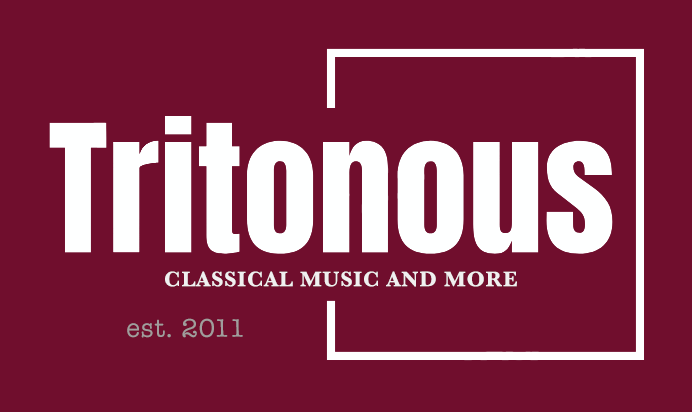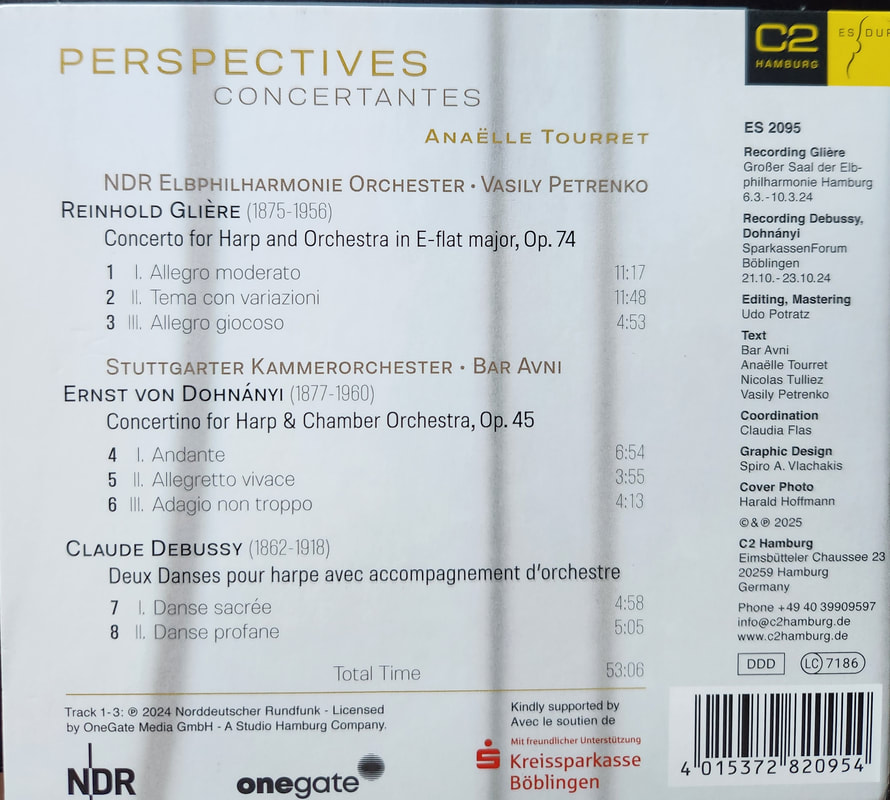This is an enticing program of harp concertante music featuring French harpist Anaelle Tourret. It begins with a full-scale concerto by the sadly underrated composer, Reinhold Gliere. I was interested in hearing how the harp would compete to be heard over a full orchestra. Well I needn’t have worried. The recording engineer has done a terrific job with balances, and Vasily Petrenko keeps the NDR Elbphilharmonie Orchestra (of which Tourret is principal harpist) firmly under control, allowing the harp to be heard clearly without being at all spotlit by the microphones. And the result is sheer loveliness.
The first movement Allegro moderato is tuneful, with delectable string writing, yet with a transparency in the orchestration suitable for a harp concerto. Petrenko insists on delicacy from the orchestra, while encouraging expressiveness (especially from the strings), and establishes a forward-moving, flowing tempo which seems perfect for the music. And Tourret immediately demonstrates an impressive mastery of the harp.
An interesting (and expansive) Theme and Variations occupies the central movement, with enormous variety and colorful orchestration which often reminded me of Tchaikovsky. Tourret displays inspired musicality and effortless virtuosity here in music which sounds quite challenging. The short finale, an Allegro Giocoso, is giocoso indeed, even though it sounds to be even more demanding of the soloist. There are flourishes and arpeggios aplenty, and even a glamorous double-handed glissando just before the 2nd theme is introduced. This is lovely music, and Petrenko continues to be a sensitive (if slightly reserved) partner.
What a wonderful piece this is – as is the Concertino by Ernst Von Dohnanyi which comes next on the program. I wasn’t sure what to expect from this Hungarian composer’s harp concerto, written late in life out of financial necessity rather than artistic inspiration. While Dohnanyi was an exact contemporary of Gliere, he composed this relatively short concertino in 1952, just 14 years after Gliere’s, and it sounds fascinatingly more contemporary and harmonically expansive. And lighter in spirit (and texture) than I would have expected from him. It is a single movement comprised of 3 contrasting sections, flowing without interruption. The opening is a harmonically enterprising, melodically searching (almost yearning) Andante, which soon becomes turbulent, with some vigorous, rapidly repeated, double-strummed chorded passages in the harp – very impressively played. And it didn’t take long before I began to recognize and appreciate the excellence and inherent musicianship of conductor Bar Avni, as she again and again demonstrates the importance of the orchestra as an integral (and equal) part of the music.
This leads without pause into an Allegretto vivace, which is an absolutely charming scherzo with ebullient filigree darting back and forth between harp and sparkling woodwinds. It was over far too soon, and the piece ends, rather unusually, with an Adagio. But Avni wisely keeps it moving, more like a free-flowing Andante cantabile than a somber adagio, allowing the poignant melodies to sing ever so sweetly – from harp and orchestral soloists alike. It is very moving, and surprisingly, makes an extremely satisfying conclusion to a glorious piece of music.
I was intrigued by the scoring in this work, which integrates the harp into the orchestral tapestry rather more than the soloistic prominence Gliere affords it in his. There are appealing melodic passages passed around from harp to various woodwinds in the orchestra, as if in friendly conversation, which keep the listener thoroughly engaged. And along with the marvelous harp playing, I continued to enjoy the wonderful contribution from Avni and the Stuttgart Chamber Orchestra, who provide an enthralling, dynamic presence so vital to the piece.
I had never heard either of these concertos before and was captivated by their charming appeal – and even more so by the enchanting expressiveness and sheer accomplishment of the playing.
Closing the concert is Debussy’s beloved Sacred and Profane Dances. And as wonderful as the concertos are, it is in this more familiar music where the mastery and masterful musicianship of Tourret and Avni become even more fully revealed. It’s one thing to bring neglected, relatively unknown masterworks to life; it’s another level of artistry altogether to make the familiar sound new and fresh. And that’s exactly how I hear their Debussy.
Right from the very first measures, there is an endearing tenderness to the harp’s phrasing which is beguiling, followed by lovely expressiveness from the strings, with a touching intimacy to their vibrato. Avni elicits an elasticity of phrasing which doesn’t interrupt tempos, but allows a certain freedom of expression – a slight relaxing here, a pushing ahead there – which is quite extraordinary.
This seductive phrasing is even more exquisitely portrayed in the Profane section, helped immeasurably by Avni’s perfectly executed tempo, which is slightly more moving than usual, inspiring the music to positively dance. (Too often this is either too sluggish or afflicted with too much rubato, which keeps the music steadfastly earthbound.) This performance demonstrates exactly what the tempo should be, and the music is lifted aloft. And again I notice the impressive dynamic range, just as in the Dohnanyi before – an element often overlooked in this music, but once heard, becomes absolutely essential for bringing it to life. Avni’s orchestra shows no signs of restraint as their sound fills the spacious acoustic with resplendence and grandeur.
Tourret and Avni are perfect musical partners – ever responsive to one another, as if playing chamber music. This is surely one of the most wondrous and enraptured recordings of the Debussy I have heard. (And it is better recorded than most.)
This CD appears on the ES/DUR (C2 Hamburg) label, in joint production with NDR and distributed by Onegate Media. The recording quality throughout is excellent. Even though the Gliere was made in a different venue (in Hamburg), there is an appealing naturalness to the recorded sound with both orchestras. However, the acoustic is even more luscious in Stuttgart – just a bit more spacious, airy, colorful and warmly reverberant (but not too much). One would never guess a chamber orchestra is utilized here, so richly imbued with warmth, color and texture is their sound.
I was somewhat apprehensive that an entire disc of harp music would be a bit too much of a good thing – but that was far from the case. Each piece is so uniquely individual, not only musically, but in the scoring as well, that I fully appreciated the “Perspectives” theme of this album. Never once, not even for a moment, did I experience a feeling of “sameness” while listening to it. I was fully engaged and immersed in the music from beginning to end. While I am certainly not an expert on harp playing, I can wholeheartedly say I enjoyed this release enormously – far more than I ever would have expected.
Wonderful harp concertos from Anaelle Tourret












